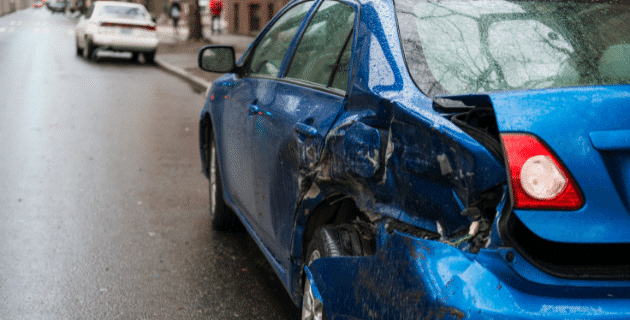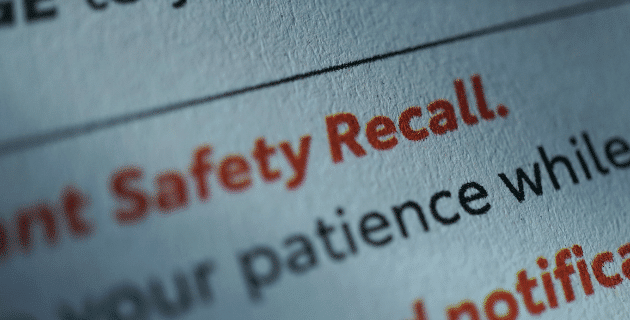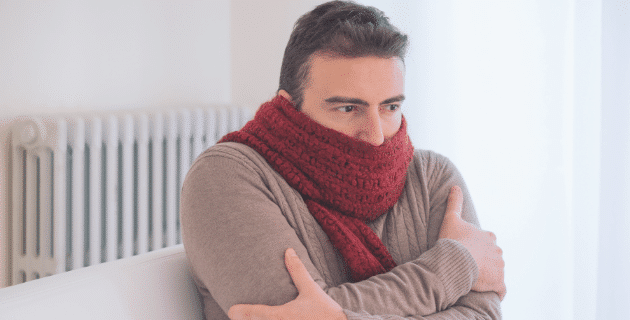
by California Casualty | Auto Insurance Info |
No matter the situation, it’s stressful to be in a car crash. It’s even more nerve-wracking if the other driver refuses to stop. In a hit-and-run, you’re left all alone with all of the damage—and if you can’t find the other driver—the cost.
A hit-and-run is defined as a collision where at least one driver leaves the scene without sharing information or offering help. In most states, this is against the law, but it happens more often than you think- every 43 seconds someone is the victim of a hit-and-run. If there’s damage to your car, a hit-and-run could be a misdemeanor but if there’s also injury, it could be a felony.
So what do you do if a hit-and-run happens to you?
Step #1: Safety comes first. Check for injuries and that you’re in a safe location.
If you’re hurt and need immediate medical attention, call 9-1-1. If your car is in a dangerous location, and could be hit again, move it out of harm’s way.
Step #2: Look for a witness.
Look for a witness. If witnesses are nearby, ask if they’d make a statement. Take their contact information to share with police. (This is good advice for any type of accident.)
Step #3: Write down as much information as you can. Take photos.
Take a moment and write down what you remember about the accident, including the most important thing—the license plate number if you saw it. That will help the police to locate the vehicle. Also include information about the other car, such as the vehicle’s make and model, color, and direction of travel. If you saw who was driving, include a description of that person. Then, take photos of the damage to your car and the place where the accident occurred.
Step #4: Stay where you are and call the police.
In some states, it’s legally required to call the police. You’ll want to do so even if it’s not and even if the damage wasn’t serious. The police need to get out there immediately to make a report from the scene of the accident so that they can help to track down the other driver. In addition, your insurance provider will likely ask for a copy of the police report. Police reports document any physical evidence such as tire marks as well as any witness statements.
Step #5: Call your auto insurer.
Let your insurer know about the accident and file a claim. Calling your insurance company will allow you to find out coverages available, limits, and deductibles. If you don’t have a body shop, they can often refer you to one in your area. At California Casualty, we call these “GRN’s” – Guaranteed Repair Network. These approved independent facilities meet the company’s strict customer service and quality standards. Your insurer will let you know about the repair process and will share information on whether your policy covers a rental car while your vehicle is being repaired.
Step #6: If you need a tow, call roadside assistance.
If your car is damaged to the point where it cannot be driven, have it towed to your body shop.
Know your towing limits. Some coverage will take your car to the nearest place of repair. You may have to pay out-of-pocket if you to tow your car further. Finally, before any work can be done to repair your car, you will want to verify the process with your insurance company.
Who pays for repairs from a hit-and-run?
If you’re able to locate the other driver and he/she is insured, you will be able to file a claim with the driver’s insurance company. If that’s not the case, you have a couple of options. These vary by state and are also determined by how your insurance company handles hit-and-run accidents.
Collision Coverage
Your collision insurance kicks in if you don’t have underinsured or uninsured motorist coverage. If your car is totaled, collision coverage offers either “actual cash value” for your vehicle or the amount necessary to repair or replace the vehicle with another of similar kind and quality—subject to the deductible. There are certain cases where the deductible could be waived; check with your insurer. Collision applies both to accidents with other drivers and collisions with objects such as a fence or mailbox. It also covers vehicle rollovers. Unlike liability insurance, collision coverage is not usually required—unless you’re leasing a car or paying off a loan on a vehicle. However, it may be good to have, especially in the event of a hit-and-run.
Uninsured/Underinsured Motorist Property Damage
One reason that a driver might run from the scene of an accident is if he or she does not have car insurance. If that’s the case, even if the police identify the driver, you cannot file a claim with his/her insurance company. If you have uninsured/underinsured motorist property damage, you can use that to pay for repairs. These are optional coverages in the majority of states. In some states, you are not allowed to carry collision and UMPD at the same time. Also, sometimes UMPD has a policy maximum, or cap on the amount it will pay. If you have UMPD/UIMPD, and it isn’t enough to cover the total cost of your car, your own collision coverage will help.
Having the right coverage is important for protecting your vehicle and keeping you from having to pay thousands in the event of an accident that is not your fault. Schedule an annual review with your insurer to make sure you are fully protected. Then, stay on top of your coverage by managing your account online.
This article is furnished by California Casualty, providing auto and home insurance to educators, law enforcement officers, firefighters, and nurses. Get a quote at 1.866.704.8614 or www.calcas.com.

by California Casualty | Homeowners Insurance Info |
You found the perfect place to rent, and you’re ready to go. Moving company, check. Boxes and bubble wrap, check. Renter’s insurance?
If you’re wondering whether you need to purchase renter’s insurance, here are the most frequently asked questions.
What does renter’s insurance cover?
Renter’s insurance is like homeowner’s insurance but for tenants. As a start, it protects your personal belongings (that’s right, your landlord’s insurance policy will not cover your belongings) but that’s not all. It’s an important safeguard if you’re found at fault for property damage or injuries at your place (and even around the world). It also can help if you don’t have access to your apartment or home due to a covered loss.
Renter’s insurance policies offer (1) personal property coverage, (2) liability insurance, and (3) additional living expenses when your apartment or home is uninhabitable.
What is personal property coverage?
Personal property coverage protects your possessions. If they are stolen, or damaged by fire/smoke or other covered “perils,” your policy will pay for them. You’ll simply have to cover the smaller upfront fee known as the deductible.
You may choose the replacement cost or the actual cash value (ACV) for reimbursement. ACV is the amount the item is worth, minus depreciation for its age. It will cost a little more for a policy that provides replacement cost since that is higher than ACV.
With personal property coverage, you choose the amount of coverage based on how much your stuff is worth. The good thing is that your possessions are insured whether they’re at your place or away from it. For example, if you have a child away at college, who has an item stolen, your policy will pay 10% of your Personal Property Coverage C limit.
Note: Some policies limit certain types of possessions, such as jewelry. If you want a higher limit, you will need to add it to the policy.
What is liability coverage?
Liability coverage protects you if someone is injured and you’re legally liable. It could be at your place or it could be anywhere in the world. For example, if your dog bites someone, you’re covered. The policy pays for the bite victim’s medical expenses and covers court fees if they sue you. Liability also covers accidental damages to the place by you or your guests. So, if you accidentally set fire to your apartment, you’re covered. There are limits, so talk to your insurance advisor about an umbrella policy, which will provide much greater coverage.
What is loss of use coverage?
If a covered danger, like a fire or an evacuation, causes your residence to be unfit to live, your policy reimburses you for additional living expenses. For example, if you normally spend $200 per month on food and now it’s costing you $300, the policy will reimburse the additional $100. There’s a time limit and a dollar limit on this, so check on your policy’s details. Payment will be for the shortest time required to repair or replace the damage or, if you permanently relocate, the shortest time required for your household to settle elsewhere. It’s worth noting that if you have a Coverage Enhancement, there’s no deductible.
What exactly is the deductible?
If a loss does occur, a deductible will often apply. A deductible is the amount that you are responsible for, before the policy pays anything. So, before you get replacement or ACV for your possessions, you pay the deductible out of your pocket. Your deductible could be $250, $500, or more. You have a choice on the amount of the deductible. The lower the deductible, the more expensive the policy.
Note: There are times when there is no deductible. In a personal liability policy, for example, a deductible does not apply.
What isn’t covered by renter’s insurance?
Renter’s insurance doesn’t cover every situation. It does not cover damage from earthquakes, mudslides or floods. It does not cover infestations of rodents or bugs. There’s only limited coverage for theft of jewelry and firearms. A standard policy doesn’t cover your roommate’s possessions (though you could add them as an endorsement known as “Other Members of Your Household” for little or no cost). Renter’s insurance also doesn’t consider your car as one of your possessions. You need a separate auto insurance policy.
Note: Ask your insurer about home office and business computer coverage. That’s different than a personal policy.
Is renter’s insurance required?
Renter’s insurance is not mandated by law, but it may be required by your landlord, property manager or owner. Renter’s insurance helps keep others, including you, from seeking damages from them, even though they’re not responsible for your possessions. If you accidentally start a fire, the landlord’s insurance kicks in after they pay the deductible. But they could use your renter’s policy to cover that cost, so it’s a win-win for them.
What happens if you don’t have renter’s insurance?
If you don’t have renter’s insurance, you’re fully responsible for any property damage or loss. You’ll have to replace your possessions in the event of theft, fire, or other perils. You’ll have to pay the medical costs of anyone injured in your apartment. You’ll have to pay for additional living expenses if your apartment is inhabitable.
How expensive is renter’s insurance?
Renter’s insurance is surprisingly affordable. For as little as $10 a month, you can get a renter’s policy at California Casualty. The cost varies depending upon the coverages you choose, the deductible, your financial responsibility score, and multipolicy discount. Even your location can have an impact. Areas with higher crime rates will have higher insurance rates.
How much renter’s insurance do you need?
You want to have enough insurance to cover your possessions and any potential liability. Start by taking an inventory of what you own and putting a dollar figure on replacing our possessions. Then, take a look at your liability. Do you entertain a lot? Do you have pets? Determine the potential for injuries on site or any other property damage. You also want to take into consideration the amount of assets you have – such as your savings, etc. You want to make sure the amount you select will cover your assets. Then, choose the deductible that is affordable for you.
Can you get renter’s insurance after you’re already moved in?
Yes. You may purchase renter’s insurance at any time. However, it’s not retroactive. You cannot buy it after there’s been damage or theft.
Not all renter’s insurance is the same. Some policies cover more than others and costs vary. Check with your insurance provider to find out the options.
This article is furnished by California Casualty, providing auto and home insurance to educators, law enforcement officers, firefighters, and nurses. Get a quote at 1.866.704.8614 or www.calcas.com.

by California Casualty | Travel |
Looking forward to relaxing on a warm beach, hitting the slopes on a scenic mountain, or choosing day trips for a stress-free staycation this Spring Break?
Check out our timesaving guide for planning your next vacation or staycation.
Set your budget.
Where can you go and what can you do? It depends on your budget. A travel budget is not an ironclad number; it’s more of an estimate. Think of a figure that you’d be willing to spend on a vacation or a staycation. Then determine if that amount covers the major expenses of your trip: accommodations and travel expenses.
-
- Research travel deals and airfare specials.
- Check out the rates of less popular airports near your destination to save money.
- Rent a car instead of flying.
- Check out different lodging options.
Choose your destination.
What’s your vacation style? Maybe you like touring museums and cultural attractions or you prefer lounging by the pool. You might like being active, such as skiing, hiking, or bicycling. The types of vacation that you most enjoy will help determine your destination. Match that to the budget and you’ll be able to choose a great destination.
-
- Take advantage of discounts, such as credit card points, AAA, or military.
- Check out additional discounts on Groupon, Kayak, Priceline, booking.com, and other services.
- Book your airfare and/or reserve your rental car.
- Create a draft travel itinerary. Buy tickets for popular activities so you won’t arrive and find them sold out.
Select your accommodations.
You may not be spending a lot of time in your room, but you do want a central location that allows you to do what you want to do. In some cases, like on a staycation, your lodging may be your entire vacation because it provides everything you need.
-
- Determine the amenities that are important to you. Do you want a kitchen where you can cook meals? A beachside location? A place that’s walking distance to everywhere you want to be? On-site entertainment? All-inclusive services?
- You can stay in a hotel, a cabin, a treehouse, a resort, a bed-and-breakfast, on a cruise ship, or any of a number of options. Choose the right lodging for your vacation style and your budget.
- Do you have friends or family that you’d like to visit? Consider staying with them and incorporating them into your vacation plans for all or part of spring break. Alternatively, see if they’d like to swap houses with you for the week.
Purchase insurance just in case.
Accidents happen and plans change. That’s where travel and rental insurance come in. Travel insurance can reimburse you if you are unable to go on your trip. Rental car insurance can help in the event of a collision or other damage to your rental car.
-
- Before you purchase rental car insurance, make sure your auto policy doesn’t already cover rental cars. Many policies do.
- If you’re renting a car out of the country, double-check that your auto policy covers you. For example, when traveling in Mexico, you will need a special Mexico policy.
- Travel insurance comes in many varieties. You can get trip cancellation, trip interruption, or trip delay insurance. You also can get baggage loss coverage. Talk to your insurance provider about what is available to you.
- You also can get medical expenses and medical evacuation coverage. This is important for trips outside the country. Once again, speak to your insurance provider to make sure you qualify for the coverage.
For the foreseeable future, you will want to take precautions to guard against COVID-19. After all, it’s no fun to be sick on vacation; neither is it a good idea to bring a virus back to your students. When traveling, follow these guidelines.
-
- Some destinations require COVID tests. Know the rules and regulations so that you can schedule your test before your trip or at the airport.
- Wear your mask at the airport and on the plane.
- Wash your hands frequently.
- Avoid crowds where possible, and stay 6 feet away from others.
Plan a staycation.
A staycation can be as much fun as a vacation with the advantage of being a lot more affordable. While you can certainly use the time for projects around the house, you can enjoy a real break by planning day trips and fun activities.
-
- You don’t technically have to stay home during a staycation. Consider one or two nights at a local hotel or other fun lodging.
- Choose a theme for your staycation, such as gourmet traveler, spa serenity, or tourist in your own town. Use it to inspire your activities.
- Enjoy fun takeout or restaurant meals that make the week feel special.
- Disconnect from social media and the news. Enjoy movie nights, game nights, and other interactive fun.
- Don’t forget that Educators & ESPs can win a $10,000 Staycation Giveaway from California Casualty!
What are your plans this Spring Break? Share it with your colleagues in the comments.
This article is furnished by California Casualty, providing auto and home insurance to educators, law enforcement officers, firefighters, and nurses. Get a quote at 1.866.704.8614 or www.calcas.com

by California Casualty | Auto Insurance Info |
We want our cars to be safe and reliable, yet sometimes, parts malfunction. When it’s a defect that creates a safety risk, the automaker is responsible for fixing it. That’s when you get an auto recall notice. These notices inform car owners that something needs to be adjusted or replaced to make their vehicles safe to drive.
How common are recalls?
Recalls happen all the time. In 2020, there were nearly 900 safety recalls affecting 55+ million cars and equipment, according to the National Highway Traffic Safety Administration (NHTSA), the government agency responsible for exploring safety complaints. NHTSA looks at safety issues, both large and small. If the car doesn’t meet the minimum safety standard, automakers are required to announce a recall. The recall is usually for a specific make and model. The vehicle manufacturer is legally obligated to inform buyers and cover the costs of repairs. Even so, only about 75% of vehicles recalled in a given year are ever fixed, according to NHTSA.
Note: There is a time limit on recalls, usually 8 years. A repair after that timeframe usually means you have to cover the cost.
Why might my car be recalled?
Recalls affect parts of the car that could cause an immediate safety hazard. They could be small or large, and include airbags, tires, brakes, engines, and electrical components. They would not, however, include air conditioners, radios, or ordinary wear and tear. One recall that occurred this past year was for the seat belt in a Ford Motor F-150 Super Cab. The belt was installed incorrectly and as a result, didn’t provide enough restraint in the event of a crash. Takata airbags again surfaced this year as NHTSA looked at 20+ automakers who used the potentially explosive bags. Other 2021 recalls were for brake issues, hood problems, battery fire hazards, and diesel engine stalling, according to Car and Driver.
Why do people sometimes ignore recalls?
It may be because they are not aware of the recall. Perhaps the notice was mailed to an old address and not forwarded. Maybe they think it will take too much time or effort, or they could be without a car. Finally, they simply may not care.
Why should I pay attention?
It’s easy to ignore recall notices. Don’t. Even a small defect can put you in a life-threatening situation. Plus, ignoring a recall can affect your insurance. If you’re involved in an accident and the faulty part is the cause, you might not get reimbursed for repairs or for medical costs.
How do I know if my vehicle has been recalled?
If you’re the original owner of the car, you should get a recall notice in the mail. If you take your car in for regular maintenance at the dealership, you also should be notified. If, however, you purchased the vehicle as a used car, and you get your car serviced at a local mechanic, you may not be aware of a recall. It’s easy to check, however. Visit the NHTSA recalls website and input your vehicle identification number (VIN). You’ll find this 17-character number on the lower left of your car’s windshield, on the inside of your driver’s side door, or on your registration or insurance documents. Not only can you check car recalls, but you can find recalls on child car seats and tires. You can also download the app to your phone and get alerts.
What do I do if I get a recall notice?
If your car is recalled, contact the dealership and schedule a repair as soon as possible. Ideally, the dealership will provide a loaner car but if not, you may qualify for a rental car with your auto policy or be reimbursed. If the dealer gives you a rental car while yours is being repaired, you’ll want to verify that you have the right insurance coverage for a loaner. Finally, if you already fixed the defect before you learned about the recall, you can get reimbursed from the dealership.
Recalls keep us safe. Other ways that you can stay safe are to wear seat belts, practice defensive driving techniques, and maintain and insure your vehicle. After all, your car is one of your greatest investments. Safe travels.
This article is furnished by California Casualty, providing auto and home insurance to educators, law enforcement officers, firefighters, and nurses. Get a quote at 1.866.704.8614 or www.calcas.com.

by California Casualty | Homeowners Insurance Info |
The furnace is the unsung hero of winter, soldiering on to keep us warm and toasty during the most frigid months of the year. However, we give little thought to this essential household item, unless it becomes temperamental or stops working altogether. When your furnace goes out in the dead of winter, do you know what to do? Is it an easy fix? Should you call a professional?
Here’s what you need to know before the temperature dips too low.
Clogged air filter
Your furnace has an air filter that traps dust and debris. When the filter is clogged, your furnace has to work harder. Dirty filters cause short cycling times. The lack of fresh air into your furnace causes the heat exchanger to get too hot, and shut down, which makes it hard for your home to stay warm. A furnace that doesn’t produce enough heat typically is due to an air filter problem. Plus, dirty filters hurt the air quality in your home. If you don’t keep up with air filter replacements, it could lead to a costly expense—that of a cracked heat exchanger. To prevent issues, change your filters regularly as part of your seasonal maintenance. For paper filters, change them every 3-6 months. For fiberglass filters, change them every 2 months.
The quick fix: Change your air filter. You can tell that it’s time to do so if you hold it up to the light, and no light shines through. Make sure to insert the new filter correctly. Air filters are made to trap debris blown from one direction. Installing a filter upside-down can limit its effectiveness.
When to call a professional: If you have electrostatic filters, they can last for years if cleaned regularly. Ask your furnace professional how to change these filters. Finally, if you do have a cracked heat exchanger, that requires a professional.
Blower issues
Furnaces that are not blowing air or those that are continually blowing air are both a problem. If your furnace is not blowing air, it could be clogged. Or it’s possible that the access door to the furnace door is off or unhinged. The safety switch on the door prevents the fan and burner from coming on unless the door is shut. Alternately, if the blower continually runs, the heat rises, which means the limit switch isn’t doing its job. It’s supposed to shut down the blower when the temperature inside the furnace becomes dangerously hot. A bad limit switch will significantly shorten the lifespan of your furnace blower.
The quick fix: For furnaces that are not blowing air, you can clean your blower fan. This requires removing the blower from the furnace. Call a technician if you haven’t done this before or if the red light is flashing on your unit, signaling a problem.
When to call a professional: A bad limit switch needs to be replaced. This has to be done by a professional.
Malfunctioning thermostat
The thermostat is the control center of your home heating system. When it’s not working properly, your furnace won’t function at its best either. It could be cycling on and off more than usual or fail to produce enough heat. The fan could be running constantly. This drains the battery and causes your furnace to work inefficiently.
The quick fix: For electronic thermostats, try replacing your thermostat’s batteries. For manual thermostats, take off the thermostat cover and dust the inside with a small brush. Look for a tripped circuit breaker and reset it, or a blown fuse and replace it. Set the fan on auto and see if your furnace runs constantly through all heat settings.
When to call a professional: If your wires are connected but the thermostat isn’t working properly, call an expert. He/she will be able to test the wires individually to determine which is faulty.
Pilot light/electric ignition
Your gas furnace has a pilot light, which ignites the natural gas pumped into the main burner. Your electric furnace has an electric ignition, which performs a similar function. If these are not working properly, you could have problems getting heat. A gas pilot light should be blue; that indicates it’s burning properly with enough oxygen. If it’s flickering yellow, that could be a sign of excess carbon monoxide or dirt built up on the intake valve, preventing oxygen from feeding the flame.
The quick fix: If it’s a gas pilot and it’s simply gone out, try relighting. It. If it’s an electric ignition, check to make sure it’s not a tripped breaker causing the problem. You can also try turning off your furnace’s supply of power, wait for 10 minutes, and turn it back on.
When to call a professional: If you relight the gas pilot and it keeps going out, call a professional. If the pilot is yellow or orange, that also warrants a professional look. It could be caused by an old igniter or a faulty temperature limiting switch.
Rumbling, squeaking, and rattling noises
If your furnace is making noises, chances are something is wrong. A high-pitched squeal could be a frayed or slipped blower belt, which helps your furnace fan run. Worn-out ball bearings could cause a scraping sound. If your furnace makes a loud sound when you start it up, that could mean there’s oil buildup in the chamber and it’s ignited all at once. Rattling could be caused by a loose duct. Whistling could be caused by a clogged air filter.
The quick fix: If you hear whistling, try replacing the air filter. If your furnace is rattling or vibrating, make sure loose ducts are screwed down properly. You can also try to add some pads under the furnace to level it.
When to call a professional: If you hear a scraping sound, turn the furnace off immediately and call a professional. Do the same if there’s a loud sound upon starting up the furnace. It’s a good idea to get sounds checked out to prevent future problems and potentially dangerous situations.
Leaking water
Standard furnaces don’t produce water but high-efficiency models do. There are several causes for a furnace leaking water, including a clogged condensation tube or drain hose. Loose connections, cracks, and holes can also cause water to leak. Condensate pumps typically last for 3-5 years; they can also start malfunctioning after that time.
The quick fix: Turn off the system either by the switch on the unit or the breaker. Clean up the water from around the base. You can use a wet-dry vacuum if needed to unclog the condensate drain line.
When to call a professional: You will need a professional to replace your condensate pump and any other parts.
Safety first
Keep in mind that do-it-yourself furnace repair does present some potential safety issues, from fire and other winter home hazards to carbon monoxide poisoning. Small repairs done improperly can lead to bigger issues, and you might void the warranty on the appliance if you accidentally cause a larger problem. Unless you received training in furnace repair, limit your fixes to the simple ones. Leave any mechanical repairs to the professionals.
Homeowner’s insurance covers repairs or replacement of furnaces if they are damaged by a covered condition on your policy, such as water damage from a burst pipe. Check with your policy provider to find out more.
This article is furnished by California Casualty, providing auto and home insurance to educators, law enforcement officers, firefighters, and nurses. Get a quote at 1.866.704.8614 or www.calcas.com.





